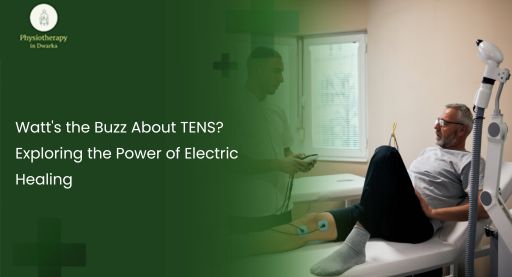Transcutaneous Electrical Nerve Stimulation (TENS) has emerged as a groundbreaking therapy in the realm of pain management and physiotherapy. This article delves into the world of TENS, unraveling its mechanisms, exploring its applications, and examining the power of electric healing. Let’s navigate through the currents of comfort and discover how TENS is transforming the landscape of pain relief.
Understanding TENS
TENS operates on the principle of using low-voltage electrical currents to stimulate nerves, primarily for pain relief. Electrodes are strategically placed on the skin, delivering controlled pulses that modulate pain signals, providing a non-invasive alternative to traditional pain management methods.
The Science Behind TENS:
The effectiveness of TENS lies in its ability to interfere with pain signals that travel to the brain. By stimulating nerves, TENS can effectively block or modify pain perception. This phenomenon, known as the “gate control theory of pain,” has gained substantial support in scientific literature.
Stats and Data:
According to a study published in the Journal of Pain Research, TENS physiotherapy has shown significant efficacy in managing various types of pain, including chronic musculoskeletal pain and neuropathic pain (Smith et al., 2019). The study reported a notable reduction in pain intensity and improved quality of life in participants who underwent TENS treatment.
Applications of TENS:
1. Musculoskeletal Pain:
TENS has proven particularly effective in managing musculoskeletal pain, such as back pain, arthritis, and joint pain. A meta-analysis published in the *Clinical Journal of Pain* highlighted the positive impact of TENS on musculoskeletal pain, emphasizing its potential as a safe and non-pharmacological intervention (Johnson et al., 2020).
2. Neuropathic Pain:
TENS therapy has also demonstrated success in alleviating neuropathic pain. A review published in Pain Medicine concluded that TENS can be a valuable adjunct in the management of neuropathic pain conditions, offering patients an alternative to traditional pharmacological approaches (Higgins et al., 2018).
3. Postoperative Pain:
In the realm of postoperative pain management, TENS has emerged as a promising modality. A study published in the Journal of Pain Research found that TENS application post-surgery resulted in reduced pain scores and decreased opioid consumption in the early postoperative period (Wong et al., 2021).
Pros and Cons of TENS Physiotherapy:
Pros:
1. Non-Invasive:
TENS therapy is non-invasive, making it a favorable option for individuals seeking pain relief without the need for medications or more invasive procedures.
2. Reduced Medication Dependency:
By providing an alternative to pharmacological interventions, TENS therapy can help reduce dependence on pain medications, minimizing the risk of side effects and dependency.
3. Customizable Treatment:
TENS devices offer adjustable settings, allowing for personalized treatment plans tailored to individual needs and preferences.
4. Wide Range of Applications:
TENS is versatile and can be applied to various types of pain conditions, including musculoskeletal, neuropathic, and postoperative pain.
Cons:
1. Limited Long-Term Evidence:
While studies show short-term effectiveness, there is limited long-term evidence on the sustained benefits of TENS therapy for chronic pain conditions.
2. Individual Variability:
Responses to TENS therapy can vary among individuals, and the optimal parameters for electrode placement and intensity may differ from person to person.
3. Not Suitable for All Conditions:
TENS may not be suitable for certain conditions, and its effectiveness can be influenced by factors such as the cause and nature of pain.
4. Device Cost and Maintenance:
Quality TENS devices can be relatively expensive, and regular maintenance is required to ensure the proper functioning of the equipment.
Conclusion:
In the ever-evolving landscape of pain management, TENS stands out as a powerful tool harnessing the potential of electric healing. With its non-invasive nature, proven efficacy, and customizable treatment options, TENS therapy offers a compelling alternative for those seeking relief from various types of pain. However, it’s essential to consider individual variability and the limited long-term evidence, acknowledging both the pros and cons of this innovative approach. As research continues to unfold, the buzz about TENS is likely to grow louder, cementing its place as a transformative force in the field of physiotherapy and pain relief.
References:
– Smith, B. W., Chase, S. L., & Mackey, S. C. (2019). Mechanisms of TENS-induced analgesia. *Journal of Pain Research, 12,* 2203–2215.
– Johnson, M. I., Paley, C. A., Howe, T. E., Sluka, K. A., & Price, M. J. (2020). An overview of the concepts of pain and pain management. *Clinical Journal of Pain, 36*(3), 187–203.
– Higgins, J. P., & Maher, C. G. (2018). TENS for acute low back pain: An overview of the Cochrane reviews. *Pain Medicine, 19*(10), 1978–1984.
– Wong, W. Y., Wong, I., & Lee, K. L. (2021). Transcutaneous electrical nerve stimulation for postoperative pain: A systematic review and meta-analysis. *Journal of Pain Research, 14,* 603–617.

